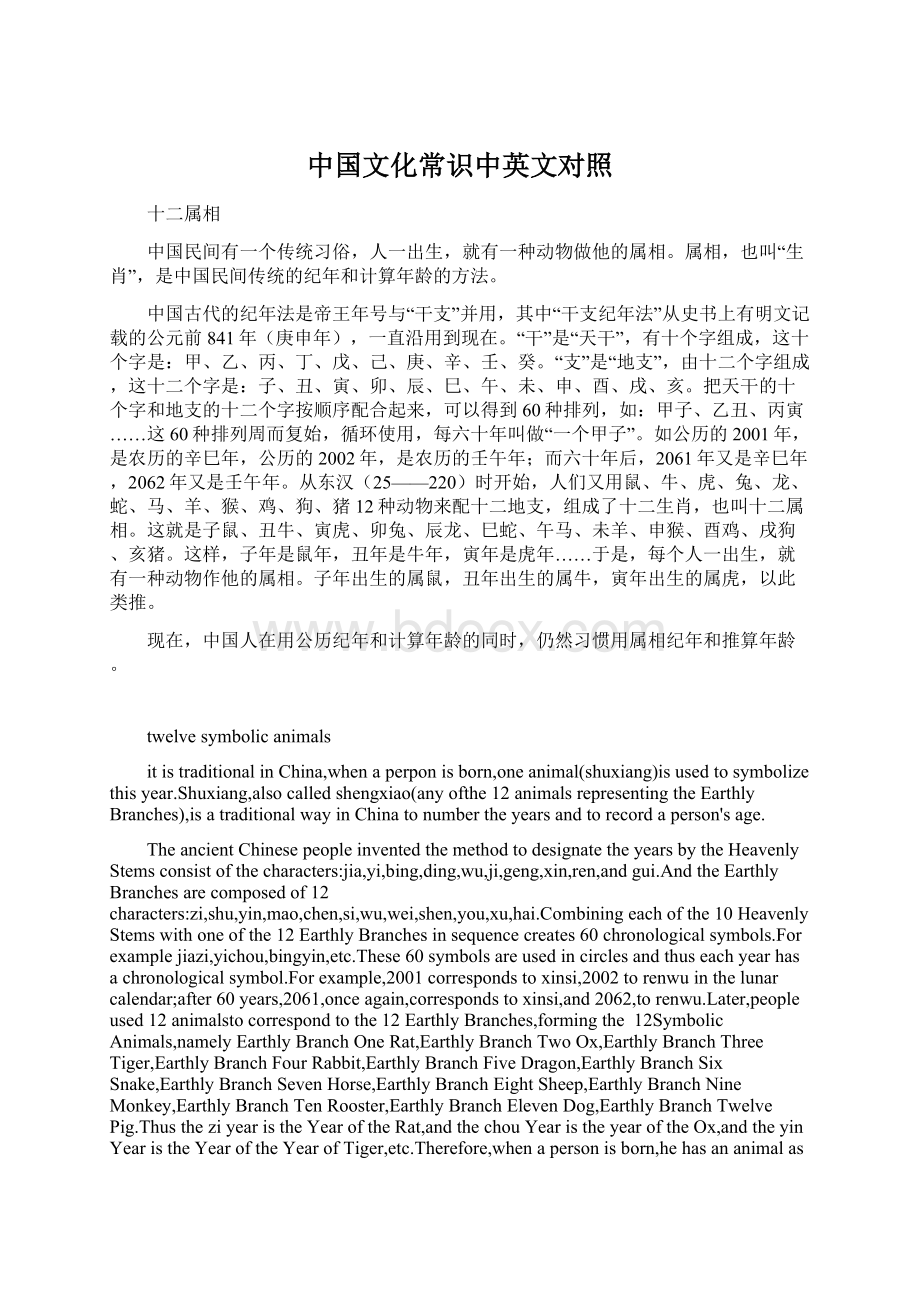中国文化常识中英文对照.docx
《中国文化常识中英文对照.docx》由会员分享,可在线阅读,更多相关《中国文化常识中英文对照.docx(9页珍藏版)》请在冰豆网上搜索。

中国文化常识中英文对照
十二属相
中国民间有一个传统习俗,人一出生,就有一种动物做他的属相。
属相,也叫“生肖”,是中国民间传统的纪年和计算年龄的方法。
中国古代的纪年法是帝王年号与“干支”并用,其中“干支纪年法”从史书上有明文记载的公元前841年(庚申年),一直沿用到现在。
“干”是“天干”,有十个字组成,这十个字是:
甲、乙、丙、丁、戊、己、庚、辛、壬、癸。
“支”是“地支”,由十二个字组成,这十二个字是:
子、丑、寅、卯、辰、巳、午、未、申、酉、戌、亥。
把天干的十个字和地支的十二个字按顺序配合起来,可以得到60种排列,如:
甲子、乙丑、丙寅……这60种排列周而复始,循环使用,每六十年叫做“一个甲子”。
如公历的2001年,是农历的辛巳年,公历的2002年,是农历的壬午年;而六十年后,2061年又是辛巳年,2062年又是壬午年。
从东汉(25——220)时开始,人们又用鼠、牛、虎、兔、龙、蛇、马、羊、猴、鸡、狗、猪12种动物来配十二地支,组成了十二生肖,也叫十二属相。
这就是子鼠、丑牛、寅虎、卯兔、辰龙、巳蛇、午马、未羊、申猴、酉鸡、戌狗、亥猪。
这样,子年是鼠年,丑年是牛年,寅年是虎年……于是,每个人一出生,就有一种动物作他的属相。
子年出生的属鼠,丑年出生的属牛,寅年出生的属虎,以此类推。
现在,中国人在用公历纪年和计算年龄的同时,仍然习惯用属相纪年和推算年龄。
twelvesymbolicanimals
itistraditionalinChina,whenaperponisborn,oneanimal(shuxiang)isusedtosymbolizethisyear.Shuxiang,alsocalledshengxiao(anyofthe12animalsrepresentingtheEarthlyBranches),isatraditionalwayinChinatonumbertheyearsandtorecordaperson'sage.
TheancientChinesepeopleinventedthemethodtodesignatetheyearsbytheHeavenlyStemsconsistofthecharacters:
jia,yi,bing,ding,wu,ji,geng,xin,ren,andgui.AndtheEarthlyBranchesarecomposedof12characters:
zi,shu,yin,mao,chen,si,wu,wei,shen,you,xu,hai.Combiningeachofthe10HeavenlyStemswithoneofthe12EarthlyBranchesinsequencecreates60chronologicalsymbols.Forexamplejiazi,yichou,bingyin,etc.These60symbolsareusedincirclesandthuseachyearhasachronologicalsymbol.Forexample,2001correspondstoxinsi,2002torenwuinthelunarcalendar;after60years,2061,onceagain,correspondstoxinsi,and2062,torenwu.Later,peopleused12animalstocorrespondtothe12EarthlyBranches,formingthe 12SymbolicAnimals,namelyEarthlyBranchOneRat,EarthlyBranchTwoOx,EarthlyBranchThreeTiger,EarthlyBranchFourRabbit,EarthlyBranchFiveDragon,EarthlyBranchSixSnake,EarthlyBranchSevenHorse,EarthlyBranchEightSheep,EarthlyBranchNineMonkey,EarthlyBranchTenRooster,EarthlyBranchElevenDog,EarthlyBranchTwelvePig.ThustheziyearistheYearoftheRat,andthechouYearistheyearoftheOx,andtheyinYearistheYearoftheYearofTiger,etc.Therefore,whenapersonisborn,hehasananimalashisaymbolicanimal.Theyear2002wasarenwuyearunderlunarcalendar,alsotheyearofHorse,andsochildrenborninthisyeaareallHorsebabies.
EventhoughtheChinesepeoplenownumbertheyearsandtheirageundertheGregoriancalendar,thestillcontinuetousethesymbolicanimals.Aslongaspeopleknowaperson'probableageandhissymbolicanimao,peoplecaninferhisexactageandyearofbirth.
小孩儿满月与抓周
在中国,小孩儿的满月酒和抓周仪式独具特色。
在孩子的成长过程中,这两个仪式有里程碑式的纪念意义。
小孩儿出生满一个月的那天,孩子的家人一般要招呼亲朋挚友,邀请他们一起来庆祝孩子满月。
按照中国的传统,这一天,家里会充满了喜庆和节日的氛围,满月就要办得热热闹闹才行。
不过最近这些年,这个习俗在城市尤其是年轻夫妇中有逐渐被淡化的趋势。
但是,小孩儿满月对于每个家庭来说,仍然是一个非常值得纪念的高兴的日子。
“抓周儿”中的“周”是小孩儿满一周岁的意思。
关于“抓周儿”,最早记载于北齐。
“抓周儿”也就是在小孩儿满周岁那天,吃中午的长寿面之前,摆上经书、笔、墨、纸、砚、算盘、钱币、账册、首饰、花朵、胭脂、吃食、玩具等,如果是女孩儿则要加摆铲子、勺子(炊具)、剪子、尺子(缝纫用具)、绣线、花样子(刺绣用具),再由大人将小孩抱来,令其端坐,父母及他人不给予任何的引导或暗示,任孩子随意挑选,看他先抓什么,后抓什么,并以此为依据来预测孩子可能存在的志趣和将从事的职业以及前途。
One-Month-OldFeastandOne-Year-OldCatch(zhuazhou)ofbabies
InChina,One-Month-OldFeastandOne-Year-OldCatchofababyareofuniqueChinesecharacteristics.Thesetwoceremoniesaremilestone-likesignificanceinthegrowingprocessofababy.
Onthedaywhenababyisamonthold,thefamilyofthebabywillinvitetheirfriendsandrelativestoaceremonytocelebratetheoccasion.InatraditionalOne-Month-OldCeremony,therewillbearejoicingand festiveatmosphereinthefamilyandthefeastissupposedtobelivelyandjoyful.However,inrecentyearsthiscustomhasbeengraduallyabandonedamongyoungpeople.Nevertheless,One-Month-OldFeaststillremainsamemorableandhappymomentforeveryfamily.
Zhouinthewordzhuazhoumeans"ababyisoneyearold".TheearliesthistoricalrecordaboutzhuazhouappeardeduringtheDynastyofNorthernQi.Onthedaywhenababyisayearold,thefamily ofthebabywilllayoutsutras,brushpens,inksticks,paper,inkslabs,abacus,coppercoins,accountbooks,jewelries,flowers,rouges,foods,toys,etc.Forgirls,scoops,scissors,rulers,thread,scissor-cutwillbeadded.Theparentsthenputthebabyinfrontofthesearticlesandmakeitsitup.Nobodywillgiveandinstructionorcuetothebabysothatitisleftfreetochoosebyitself.Watchingthebabycatchthearticlesitlikes,thefamilycanthenmakepredictionsaboutitspotentialinterests,futurecareeranddevelopment.
婚礼
结婚是人生中的一件大事。
传统的中式婚礼古朴而又热闹,隆重、喜庆并且礼节周全,场面的铺陈颇具特色,不过在现代,尤其是在城市里,已经很少见了。
花轿是传统婚礼的核心内容之一。
结婚时,新娘要坐在花轿里从娘家被抬到男方家中。
花轿一般分四人抬,八人抬两种,又有“龙轿”“凤轿”之分。
除去轿夫之外,还有持笙锣、伞、扇等的随行人员,一般的轿队少则十几人,多则几十人,很是壮观。
传统的中式婚礼中,新娘要蒙着红盖头,在伴娘的伴随下,由新郎手持的大红绸牵着,慢慢地登上花轿。
在新娘成花轿去往男方家里的途中,颠花轿是必不可少的热闹场面。
轿夫一起左摇右摆使花轿不稳,新娘坐在里面也是左摇右晃。
有的时候,新郎甚至不得不代替新娘或者和新娘一起向众人抱拳施礼求饶,而这个时候,众人欢笑不止,实际上是为了增添新人成婚之日的喜庆气氛。
中式传统婚礼的最重要的部分便是拜堂成亲。
新人走到天地桌前,上面摆放有装满粮食的斗,斗的四周写上“金玉满斗”四个大字,以红纸封口,斗内四角放若干硬币,以供拜完天地后看热闹的亲朋好友掏出来求取吉利之意。
斗中要插一柏枝,枝上缀有铜钱,这个柏枝便被称作“摇钱树”。
斗旁放一杆秤、一面镜、织布机杼、一灯或一蜡烛。
新郎在右,新娘在左,并肩站在天地桌前,执事人高声喊道:
“一拜天地,二拜高堂,夫妻对拜”。
民间的说法认为,男女只有在拜过天地后才能算作是正式夫妻,因此对这个拜堂的仪式非常重视。
还有民间习俗有这样有趣的研究,即如果新郎在结婚的当天因故不能拜天地,就让他的姐妹抱只公鸡来代替。
坐完花轿、拜完天地、接下来新人要入洞房了。
洞房是一直延续下来的叫法,新人入了洞房以后,按照习俗,新郎新娘的同辈亲友聚集在洞房里,对新郎新娘开一些充满暗示的玩笑。
这时即便过头一点,新郎新娘也不会生气,而是想办法巧妙化解,因为亲朋好友闹洞房图的是高兴和热闹。
Wedding
Marriageisthemostimportantthinginthelife.InChina,atraditionalweddingissimpleandlively,ceremonious,andjoyful.Therearesomeuniquefeaturesinthisceremony,butin modernsociety,especiallyinthecity,itishardlyseenanymore.
Thebridalsedanisthecoreofthetraditionalwedding.Inwedding,thebrideshouldsitinthesedan,thenbeliftedfromhermother'shometoherhusband'home.Generally,therearetwokindsofsedan,thatis,four-lifterandeight-lifter,alsodividedinto"dragonsedan"and"phoenixsedan".Therearesomanysuiteswhoholdgongs,umbrellas,fansandsoon,besideslifters,Ingroup,therearemorethantenpeopleatleast,andtheoccasionisverymagnificent.Inatraditionalweddin,accompaniedwithabridesmaid,thebridewearingaredveilandled alongbythebridesgroomwhoholdsaredsilkinhishand,entersthebridalsedan.Onthewaytothehusband'shome,liftersjoltthesedanasitisnecessaryinajoyfulwedding.Liftersswingthesedanfromlefttoright,causingthebridetositunsteadilyinside.Sometimesthebridegroomhastosubstituteforhisbrideorbegtoeveryoneelse,while,alllaughtoaddingtothejubilance.
TheweddingceremonyisthemostimportantpartofatraditionalChinesewedding.Thenewlywedsgotothetableforheavenandearthwherethereisadou(akindofbasket)fullofgrain.Thedouiswrittenwithredpaper.Therearemanycoinsplacedinthefourcornersofthedoutoprovidethe"luck"meaningtotheguests.Thereisacypressbranch,called"readysourceofmoney",decoratedwithcoppercoins.Besides,onesteelyard,amirror,aloom,alamporacandle arealso placednearthedou.Afterwards,thegroomstandontheleftside,thebriderightbyhisside,whilethedirectorprompts,"Firstbowtotheheavenandearth;secondbowtotheparents;thirdbowtoeachother".Accordingtothefolksaying,theywillnotbetheformalcoupleuntilbowingtotheheavenandearth.Asaresult,peoplepayagreatattentiontothisceremony.Aninterestingcustomisthatifthegroomcannotcometothisceremony,heshouldaskhissistertoholdacockinstead.
Aftertakingthebridalsedan,bowingtotheheaven,it'stimeforthenewlywedstogotothebridalchamber.Accordingtocustom,theirrelativesandfriendsgettogetherinthebridalchambertobanterthenewlyweds.Atthistime,thenewlywedswillnevergetangryenveniftheteasinggamesareabitoutrageous,butwilltrytoskillfullydissolvesincetherelativesandfriendsintendtodelightthem.
旗袍与中国传统服饰
旗袍源自清代满族女性服饰,被誉为中国传统服饰文化的典范。
它不仅在整体造型的风格方面符合中国文化和谐的特点,而且它的装饰手法也展现着浓厚的东方特质。
另外,穿旗袍可以增加形体的修长感,配上中高跟鞋,更可以抬升人体的重心,将东方女性的端庄、典雅和含蓄的美展露出来。
因此旗袍在中国民族服装中独领风骚,久盛而不衰。
中国男子的传统服饰比较有代表性的为长袍、马褂,长袍和马褂都是满族男子的服装,盘领、窄袖,马褂是对襟,大都有马蹄袖,长袍为大襟。
也有马褂、长袍相连的两部形式,这种形式的长袍只有下半截,连扣在马褂的内下摆。
长袍马褂给人的感觉是既不乏庄重,又显得洒脱和舒适。
2001年APEC会议各国元首穿着“唐装”集体亮相,掀起了一股以穿“唐装”为时尚的风潮。
将“唐装”作为中式服装的通称,主要因为国外都称华人居住的地方为“唐人街”,所以“唐人”作为中式服装的通称,主要是因为国外都称华人居住的地方为“唐人街”,所以“唐人”穿的衣服自然就叫做“唐装”了。
当今的“唐装”是由清代的马褂演变而来的,它的款式结构有四大特点:
一是立领,上衣前中心开口,立式领型;二是连袖,即袖子和衣服整体没有接缝,以平面裁剪为主;三是对襟,也可以是斜襟;四是直角扣,也就是盘扣;另外从面料来说,则主要使用织锦缎面料等。
另外,中国不动地域和不同民族的服饰也各有特色。
比如,肚兜就是关中和陕北的传统的贴身服饰,肚兜的形状就像背心的前襟,上面用布带系在脖颈上,下面两边各有一条带子系在腰间,它可以避免肚子受凉,夏天时儿童穿在外面也显得天真烂漫。
在儿童穿的肚兜上尝尝绣有虎头像和“五毒”图案,给予了大人希望孩子健康成长的美好祝愿。
再比如,中国少数民族彝族的服饰也很有特点。
彝族妇女的头饰大致有缠头、包帕、绣花帽三类,其中红河地区妇女的头饰更是琳琅满目,以银饰为贵为美。
披风是彝族男女皆备的特色服装,以动物皮毛、毛麻织品和草编织制品为原料,以青、蓝二色为主。
Cheong-SamandTraditionalChineseCostumes
Thecheong-samhasitsoriginintheManchufemale'scostumesintheQingDynastyandhasbeenregardedasthemodelofChinesetraditionalhabilatoryculture.Asforthereason,thecheong-samnotonlyaccordswithethecharacteristicofharmonywithinChinesecultureintermsofthestyle,butalsoshowsrichorientalidiosyncracywithregardtoornamentaltechniques.Inaddition,thecheong-samwillgivemorepominencetoalady's
slenderfigure,andalsohelptoheightenthecenterofgravityofhumanbodiestogetherwithehigh-heelshoes,sotahtcivility,eleganceanddignetywillbefullydisplayde.Therefore,thecheong-samdevelopeditsowntrend,whichhasbeenlonglasting.
AsforthetraditionalclothesofChinesemen,thelonggownandmandarinjacketaretypical.Bothofthemhaveroundnecksandnarrowsleeves.ThemandarinjacketcanbeseenasakindofChinese-stylejacketwithbuttonsdownthefront,mostlywithsleeveslikeahorse'shoof.However,thefrontoflonggowns,withbuttonsontheright,isbasicallylarge.Thereisalsoatypeofgarmentcombiningthelonggownandthemandarinjacket,andtheywillonlyhavetheunder-halfpart,buttoningintheunderlapofthemandarinjacket.Thelonggownandmandarinjacketwillgivertheimpressionofcomfortablenessandea